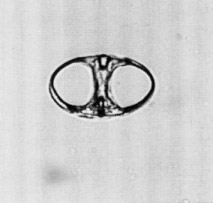 Liriospyris
parkerae Riedel and Sanfilippo
Liriospyris
parkerae Riedel and Sanfilippo Liriospyris
parkerae Riedel and Sanfilippo
Liriospyris
parkerae Riedel and SanfilippoLiriospyris parkerae Riedel and Sanfilippo, 1971, p.1590, pl.2C, fig.15, pl.5, fig.4
Sagittal ring D-shaped, with a furrow on the anterior and posterior sides. Four collar pores, separated by the median and sternal (in the sense of Goll) bars and the primary lateral spines, are enclosed within the basal ring. The remainder of the skeleton is a simple longitudinally furrowed frontal ring, except that it is divided apically to join the upper part of the sagittal ring at two points. There is no apical spine, and the vertical spine is represented by a short thorn. At the base of the apical bar of the sagittal ring is a single small pore, near which can be distinguished two very small secondary lateral bars, and near the base of the vertical bar is a pair of small pores and near them a sternal bar (in the sense of Goll, 1968) (Riedel and Sanfilippo, 1971).
Based on 25 specimens. Height of sagittal ring 50-70 µm, total width of skeleton 95-125 µm (Riedel and Sanfilippo, 1971).
The lateral part of the shell consists of a simple longitudinally furrowed frontal ring, divided apically to join the upper part of the sagittal ring at two points (Riedel and Sanfilippo, 1978a).
The lack of pores on the narrow frontal ring distinguishes this species from the otherwise similar Liriospyris stauropora. The only other species with which it might be confused is the very much larger Acrocubus octopylus Haeckel (1887, p.993, pl.82, fig.9; Goll, 1972, p.961, pl.37, figs.1-3), which is commonly about 120 µm high at the sagittal ring and 250 µm wide, and has a pronouncedly knobby sagittal ring. In only one assemblage (DSDP 316-3-2) have we found some enigmatic specimens intermediate between Liriospyris parkerae and Acrocubus octopylus. Until a satisfactory taxonomic position for these intermediate forms can be established, we exclude from Liriospyris parkerae any specimens larger than described in the "Variability" paragraph, or with knobby sagittal ring (Sanfilippo et al., 1985).
The skeleton of this spyrid, which consists essentially of two mutually perpendicular rings, shows little variability. Some early specimens are transitional to its ancestor (L. stauropora) in having a few small pores in the normally poreless, longitudinally furrowed frontal ring. The primary lateral bars are sometimes missing, or reduced to small remnants. Height of the skeleton at the sagittal ring is usually 60-70 µm, and its total width is usually 95-120 µm, but in two assemblages examined (from DSDP 79-5-1 and DSDP 369A-5-5) the height reached 75 µm and the width 130 µm (Sanfilippo et al., 1985).
L. parkerae occurs in latest early to middle Miocene assemblages from the tropical zones of all major oceans, and almost as far north as Japan (DSDP Site 296). However, it apparently does not occur off northern California (DSDP Site 173). It evolved from Liriospyris stauropora within the Calocycletta costata Zone. Its morphotypic last appearance is approximately synchronous with the lower limit of the Diartus petterssoni Zone.
This species evolved from L. stauropora by loss of the pores on the frontal ring, and left no known descendants.